| |
Heroic
Christian Holland bankrupted the Spanish Empire and thus saved
the entire world from the Spanish Inquisition!! |
|
Here
is the dictionary definition of heroic:
| HERO'IC,
a. Pertaining to a hero or heroes; as heroic valor. |
| 1.
Becoming a hero; bold; daring; illustrious; as heroic action; heroic
enterprises. |
| 2.
Brave; intrepid; magnanimous; enterprising; illustrious for valor;
as Hector, the heroic son of Priam; a heroic race. |
One
of the first nations to embrace the glorious Reformation of Saint Martin
Luther was the heroic little nation of Holland. Holland is actually
just 2 of several states comprising the Netherlands or Low Countries.
As soon as the Netherlands or Low Countries embraced the blessed Reformation,
they were exalted and very high in the sight of JEHOVAH:
Then
shalt thou delight thyself in JEHOVAH; and I will cause thee to ride
upon the high places of the earth, and
feed thee with the heritage of Jacob thy father: for the mouth of
JEHOVAH hath spoken it. (Isaiah 58:14).
One
the most famous Hollanders was
Erasmus of Rotterdam, who edited the Greek New Covenant, which Saint
Martin translated into German.
Most
people know the Netherlands as Holland or the land of the Dutch, so
that is the name we will use for this historical study.
By
1600, In spite of horrible persecution, Holland was becoming the most
advanced nation on earth. Leiden University was renowned for its learning,
and Hans Lipperskey invented the telescope which
Galileo stole and later used to "prove" his heliocentric
theory.
Because
of Holland's proximity to England, and the great increase of true Christianity
there, it was the prime target of the Spanish Inquisition.
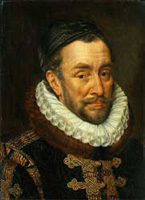
William of Orange (1533 - 1584).
Reigned from 1559 to 1584.
|
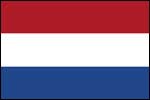
Netherlands
flag.
|
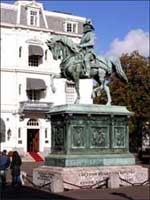
Statue
of William of Orange at the Hague.
|
William
of Orange is considered the father of his country. He was the main leader
of the Dutch revolt against the Spanish that set off the Eighty Years'
War, and resulted in the formal independence of the United Provinces
in 1648.
William
of Orange was called William the Silent!!
William
of Orange was also called WILLIAM THE SILENT and here is the reason
why: In 1558, William and King Henry II of France were hunting together
in the Wood of Vincennes. King Henry related to the Prince of Orange
a plot to massacre all the Protestant Christians in Europe:
They
appeared to receive still further authentication, at least in the
eyes of William, Prince of Orange, from the circumstance that a plot
precisely identical had been disclosed to him six years before, by
Henry II, when the king and the prince were hunting together in the
Wood of Vincennes. The rest of the hunting party had left them, Henry
and William were alone, and the mind of the French king being full
of the project, and deeming the prince, then the intimate friend both
of Philip II and the Duke of Alva, a safe depositary of the great
secret, he unhappily for himself, but most happily for humanity, communicated
to the prince the details of the plan. Henry
II told him how apprehensive he was of his throne being swept away
in the flood of Protestantism, but he hoped, with the help of his
son-in-law Philip II, soon to rid France of the last Huguenot. The
monarch went on to explain to the prince how this was to be done,
by entrapping the Protestants at the first convenient moment, destroying
them at a single blow; and extending the same thorough purgation to
all countries to which heresy had spread. William could not
have been more astounded although the earth had suddenly yawned at
his feet; however, he carried the secret in his breast from that dark
wood, without permitting the French king to read, by word or look
of his, the shock the disclosure had given him. And he retained it
in his breast for years, without speaking of it to anyone, although
from the moment of his coming to the knowledge of it, it began to
shape his conduct. It is from this circumstance that he received the
significant name of William the Silent.
(Wylie, History of Protestantism, vol. II, p. 40.)
William
was the author of the expression "loose lips sink ships."
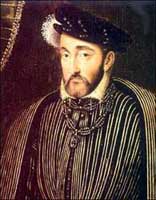
King Henry
II of France (1519-1559).
Reigned from 1547 to 1559.
|
| |
King Henry
II was killed in 1559 when a lance went through his brain
at a jousting tournament.
Catherine
de' Medici—mother in law to Mary Queen of Scots—later
helped engineered the dreadful St. Bartholomew's Day massacre.
|
|
|
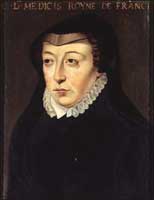
Catherine
de' Medici (1519-1589).
Wife of King Henry.
|
Thanks to new world
gold, the Spanish Empire was the most powerful in the world.
The
Spanish Empire in the Netherlands
By 1550, Spain was
the military SUPERPOWER of the world with unlimited finances from the
gold and silver mines of the New World. Nothing stood in her way to
eventual world hegemony.
In 1567, Philip
II dispatched a ruthless soldier named the Duke of Alva, with 12,000
men, to subjugate the Netherlands, and use it as a springboard to conquer
England.
Throughout Europe,
the Spanish army was notorious for their ferocity and ruthlessness.
It had taken them over 700 years to drive the Moors from Spain . . .
and suddenly they were the most feared army in the world!!
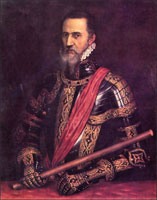
Duke of Alva
(1507-1582).
|
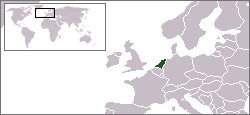
The Netherlands
was ideally situated for an invasion of England.
|

The Spanish
Netherlands.
|
This "Iron
Duke" as he was called began a 6 year reign of terror in the Netherlands.
On August 22, Alba, accompanied by a body of select Spanish troops,
made his entry into Brussels. He immediately appointed a council to
condemn without trial those suspected of heresy and rebellion. On June
1, 1568, Brussels witnessed the simultaneous decapitation of twenty-two
noblemen; on 6 June followed the execution of the Counts of Egmond and
Horne. The "Council of Blood" was the popular designation
of Alba's tribunal.
Philip
II ordered the death of all the inhabitants of Holland!!
On
February 16, 1568, the entire population of the Netherlands—three
million—was condemned to death as heretics, apart from a few named
exceptions:
Philip
next submitted a "Memorial and Representation" of the state
of the Low Countries to the Spanish Inquisition craving the judgment
of the Fathers upon it. After deliberating, the inquisitors pronounced
their decision on the 16th of February, 1568. It was to the effect
that, "with the exception of a select list of names which had
been handed to them, all the inhabitants of the Netherlands were heretics
or abettors of heresy, and so had been guilty of the crime of high
treason." On the 26th of the same month, Philip confirmed this
sentence by a proclamation, in which he commanded the decree to be
carried into immediate execution, without favour or respect of persons.
The King of Spain actually passed sentence of
death upon a whole nation. We behold him erecting a common scaffold
for its execution, and digging one vast grave for all the men, and
women, and children of the Low Countries. "Since the beginning
of the world," says Brandt, "men have not seen or heard
any parallel to this horrible sentence.
(Wylie, History of Protestantism, vol. II, p. 70.)
Ten days later, the
Spanish King Philip II ordered Alba to carry out the sentence. In the
terror which followed, the wealth of the prosperous merchants made them
a particular target, and axe, rope, and fire consumed the natural leaders
of Dutch society. Alba wrote to Philip coolly estimating the number to
be executed after Holy Week 1568 'at eight hundred heads'. Alba is said
to have admitted to personal responsibility for 18,600 executions during
his six-year tenure—a plausible figure, but the additional number
massacred with increasing barbarity by his troops is incalculable.
The
siege of Haarlem
On
December 11, 1572, the Spanish army led by Fadrique Álvarez de
Toledo, 4th Duke of Alba, began to encompass the city. Regiment after
regiment arrived until the besieging army numbered over 30,000 men.
The population of Haarlem was about 30,000, equal to the number of besiegers.
| 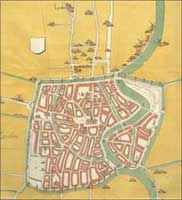
Map of
Haarlem around 1550. The city was completely surrounded by a city
wall and defensive canal.
|
| |
The
besieged Hollanders put up a heroic defense of their city
during the 7 month siege of Haarlem.
Even
the woman joined the men in defending the city.
Famine
alone caused them to surrender.
|
|
|
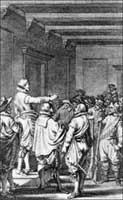
Wigbolt
Ripperda—city governor of Haarlem—admonishing the
citizens not to give in to the Spanish Army.
|
Many
a Spaniard wished he had stayed in Spain or exercised his cruelty on
the New World natives instead.
Even
the woman of Haarlem joined the men on the ramparts and sallied out
to attack the Spaniards:
The
population of Haarlem did not exceed 30,000; that is, it was only
equal in number to that of the host now encamped outside its walls.
Its ramparts were far from strong; its garrison, even when at the
highest, was not over 4,000 men, and it was clear that the defence
of the town must lie mainly with the citizens, whom patriotism had
converted into heroes. Nor did the war-spirit burn less ardently in
the breasts of the wives and daughters of Haarlem than in those of
their fathers and husbands. Three hundred women,
all of them of unblemished character, and some of high birth, enrolled
themselves in defence of the city, and donning armour, mounted the
walls, or sallying from the gates, mingled with their husbands and
brothers in the fierce conflicts waged with the enemy under the ramparts.
This army of amazons was led by Kenau Hasselaer, a widow of forty
seven years of age, and a member of the first families of Haarlem."Under
her command" says Strada, "her females were emboldened to
do soldiers' duty at the bulwarks, and to sally out among the firelocks,
to the no less encouragement of their own men than admiration of the
enemy. (Wylie, History of Protestantism, vol. II, p. 92.)
Famine
and disease finally forced the Heroic Hollanders to surrender.
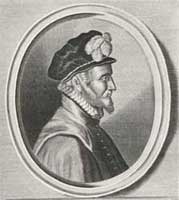
Fadrique
Álvarez de Toledo, 4th Duke of Alba, led the Spanish
besiegers.
|
| |
On July 13,
1573, the city was finally forced to surrender due to
the terrible toll that famine was taking on the citizens.
Most
of the survivors were massacred by the Spanish soldiers.
|
|
|
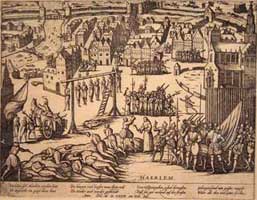
Dutch
print showing the massacre after the surrender of the city.
|
The
capitulation of Haarlem was a "victory" for the Spanish, but
many more "victories" like this would leave the Spanish Empire
BANKRUPT.
The
assassination of William of Orange
The
heroic defense of his country was bleeding the Spanish Empire dry, so
the Jesuits resorted to assassination.
| 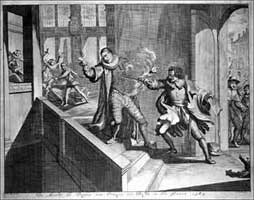
The Prince
of Orange was assassinated by a Jesuit named Balthasar Gérard
(1557-1584).
|
| |
On
July 10, 1584, the heroic Prince of Orange was assassinated
by a Jesuit assassin named Bathasar Gerard.
This
was the first murder of a world leader by a handgun.
|
|
|
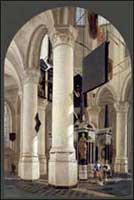
Tomb
of William of Orange in the city of Delft.
|
The resistance of
the Prince of Orange to Spanish tyranny was causing the Spanish Empire
to go BANKRUPT.
The
Dutch foiled the "Invincible" Armada!!
The basic plan of
the "Invincible" Armada was to sail up the English Channel
and rendezvous with the Duke of Parma in the Netherlands. Then the combined
fleets would cross the Channel and the invasion of England would be
a cakewalk. . . or so they planned.
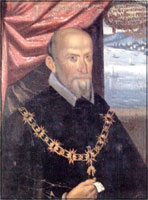
The Duke
of Medina Sidonia (1550-1615), led the "Invincible"
Armada.
|
| |
The
basic strategy of the "Invincible" Armada was
that Medina Sidonia and the Duke of Parma would shake
hands in the Netherlands.
Then
they expected to cross into England, dethrone Queen Elizabeth,
and return the land to Rome.
|
|
|

The Duke
of Parma (1545-1592), led the invasion force in the Netherlands.
|
The
ships were filled with fanatical Jesuits . . . and racks, pulleys, thumbscrews,
iron virgins, gridirons and other diabolical instruments of torture
to be used once the Spanish Inquisition was set up in England:
All the while,
Parma was as desirous to be on the scene of action as Medina Sidonia
was to have him there. The duke had assembled a mighty force. One
of his regiments was accounted the finest known in the history of
war, and had excited great admiration on its march from Naples to
the Netherlands, by its engraved arms and gilded corslets, as well
as its martial bearing. A numerous fleet as we have already said,
of flat bottomed vessels was ready to carry this powerful host across
to England. But one thing was wanting, and its absence rendered all
these vast preparations fruitless. Parma needed
an open door from his harbours to the sea, and the Dutch took care
not to leave him one. They drew a line of warships along the Netherlands
coast, and Parma, with his sailors and soldiers, was imprisoned in
his own ports. It was strange that this had not been foreseen
and provided against. The oversight reveals the working of a Hand
powerful enough by its slightest touches to defeat the wisest schemes
and crush the mightiest combinations of man. (Wylie, History of
Protestantism, vol. II, p. 445.)
Thanks to the Dutch,
the rendezvous of the Invincible Armada with the Duke of Parma never
took place.

Coastal sailing
barges of the kind gathered by Parma for the invasion of England.
|
| |
The Dutch
foiled the attempts of the Spanish fleet to link up with
the Duke of Parma. |
|
|

Dutch
warships blockaded the coast and Parma was unable to join with
the rest of the "Invincible" Armada.
|
The
gallant Dutch foiled the invasion attempt of the "Invincible Armada:"
While
Howard and Drake held the British fleet in readiness to oppose the
Spanish Armada, that of Holland, consisting of but twenty-five ships,
under the command of Justin of Nassau, prepared to take a part in
the conflict. This gallant though illegitimate scion of the illustrious
house, whose name he upheld on many occasions, proved himself on the
present worthy of such a father as William, and such a brother as
Maurice. While the duke of Medina Sidonia, ascending the Channel as
far as Dunkirk, there expected the junction of the duke of Parma with
his important reinforcement, Justin of Nassau, by a constant activity,
and a display of intrepid talent, contrived to block up the whole
expected force in the ports of Flanders from Lillo to Dunkirk. The
duke of Parma found it impossible to force a passage on any one point;
and was doomed to the mortification of knowing that the attempt was
frustrated, and the whole force of Spain frittered away, discomfited,
and disgraced, from the want of a cooperation, which he could not,
however, reproach himself for having withheld. The issue of the memorable
expedition, which cost Spain years of preparation, thousands of men,
and millions of treasure, was received in the country which sent it
forth with consternation and rage. Philip alone possessed or affected
an apathy which he covered with a veil of mock devotion that few were
deceived by. At the news of the disaster, he fell on his knees, and
rendering thanks for that gracious dispensation of Providence, expressed
his joy that the calamity was not greater. (Grattan, Holland.
The History of the Netherlands, pp. 204-205).
The British would later
show their gratitude by declaring war on Heroic Holland in 1654.
The
Battle of the Downs in 1639
In a naval engagement
entitled the Battle of the Downs, which took place off the coast of
England in 1639, the Spanish were decisively defeated by the Dutch navy.
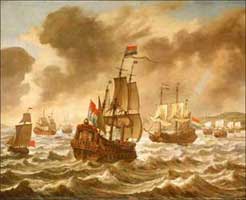
The Battle
of Downs was fought on
Oct. 31, 1639.
|
| |
The Battle
of the Downs was a decisive defeat for the mighty Spanish
navy.
It
was then that the Spanish realized that they would need
the English navy to do their fighting for them.
|
|
|
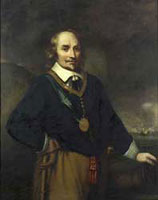
Dutch
admiral Maarten Tromp (1598-1653),
commanded the Dutch navy.
|
This victory led
to the English civil wars and the dictatorship of Oliver Cromwell.
The
beheading of King Charles I in 1649
Up
to the time of King Charles I, peace and amity existed between England
and Holland. The oldest daughter of King Charles, Mary Henrietta, was
actually married to William II, Prince of Orange. This marriage between
the Stuarts and the House of Orange cemented the friendship between
the two allies and made war highly unlikely.
Holland
was a big winner at the end of the Jesuit instigated 30 Years' War.
The Spanish Empire was the big loser, and the tiny Dutch Republic was
replacing Spain as mistress of the seas.
From
January 1631, Charles I of England engaged in a number of secret agreements
with Spain, directed against Dutch sea power. He also embarked on a
major program of naval construction, enforcing ship money to built such
prestige vessels as HMS Sovereign of the Seas. Charles's policy
was not very successful however. Fearing to endanger his good relations
with the powerful Dutch stadtholder Frederick Henry, Prince of Orange,
his assistance to Spain limited itself to allowing Habsburg troops on
their way to Dunkirk to employ neutral English shipping. In 1636 and
1637 he made some halfhearted attempts to extort North Sea herring rights
from Dutch fishermen until intervention by the Dutch navy made an end
to such practices. When in 1639 a large Spanish transport fleet sought
refuge in the English Downs moorage, Charles did not dare to protect
it against a Dutch attack; the resulting Battle of the Downs undermined
both Spanish sea power and Charles' reputation.
Obviously
the king was not cooperating with the Jesuits in destroying the Dutch,
navy so he had to be taught a lesson.
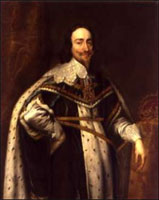
King Charles
I (1600-1649).
King from 1625 to 1649.
|
| |
King Charles
I was beheaded on Jan. 30, 1649.
Oliver
Cromwell was one of the signers of his death warrant.
The
new regime completely changed English foreign policy vis-à-vis
the Dutch. |
|
|
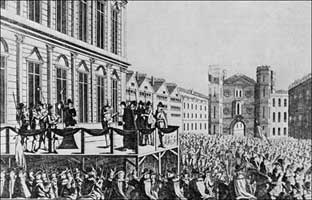
Depiction
of the beheading of King Charles I in 1649.
|
The
public beheading of King Charles I of England on January 30, 1649, took
place on a specially erected scaffold outside the Banqueting House in
Whitehall, in Westminster. One week later his body was buried in Henry
VIII’s vault at Windsor.
The
Navigation Act of 1651
Cordial
relations existed between England and Holland until the regime of Cromwell.
An act was passed by the Cromwell "Parliament" in 1651 called
the Navigation Act. It was aimed basically at the Dutch who carried
on a brisk shipping trade between the New World, England, and Holland.
The
new policy was pursued with the fervour so characteristic of all new
régimes. Moreover, when Cromwell soon afterwards rid the country
of internal enemies, there was even less reason for fearing the Dutch.
Charles II, defeated at Worcester in September, once again took refuge
on the continent; Scotland and Ireland lay at Cromwell's feet. By
October, Parliament felt free to pass the contentious Navigation Act
which provided that all imports should be brought into England in
English vessels or vessels of the country producing the goods. The
Act was clearly directed against the Dutch traders; it denied them
the freedom of the seas on which they had insisted throughout the
negotiations at the Hague. Soon afterwards, the English government
gave an even stronger proof of its hostility to the United Netherlands,
when it issued letters of reprisal to the heirs of an English merchant,
who was said to have suffered damage by the Dutch. These letters not
only caused the Netherlands an unexpected financial loss, but involved
recourse to a maritime law that had always been resented by the Dutch
and had been the subject of long and tedious negotiations with the
kings of England. To top it all English men-of-war began to search
Dutch ships quite arbitrarily for 'contraband.' (Geyl, Orange
and Stuart, pp. 89-90).
Cromwell
went to war with the Dutch!!
Spain
was the FIRST country to recognize the Cromwell regime....Cromwell declared
war on England's faithful ally the Dutch. The first of the Anglo-Dutch
wars lasted from 1652 to 1654.....Of course the Jesuits were DELIGHTED
that the British were fighting for them and destroying the Dutch navy.
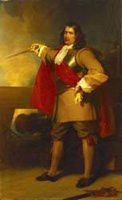
General Robert
Blake (1599-1657),
commanded the English navy.
|
At
least 8 great sea battles were fought between the English and
Dutch:
| Battle
of Goodwin Sands |
| Battle
of Plymouth |
Battle
of the Kentish Knock |
| Battle
of Dungeness |
| Battle
of Portland |
| Battle
of Leghorn |
| Battle
of the Gabbard |
| Battle
of Scheveningen |
|
 Dutch admiral
Maarten Tromp (1598-1653),
Dutch admiral
Maarten Tromp (1598-1653),
commanded the Dutch navy. |
Most of the generals
that fought for Cromwell also remained in the English navy after the
restoration of Charles II.
The
Glorious (Dutch) Revolution of 1688!!
By
1688, King James II was absolutely determined to turn back the clock
(which only God can do), and restore Roman Catholicism in England. England
was rescued from such a dire fate by the invasion of the Protestant
King William of Orange. William III was the great-grandson of the heroic
Prince of Orange.
The
gallant Dutch could have left England to that dreadful fate because
of their many wars against their country and colonies. As true Christians,
they did not render evil for evil, but came to the rescue of the beleaguered
country.
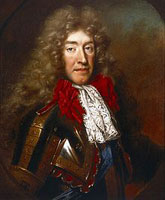
King James
II (1633-1701).
King from 1685 to 1688.
|
| |
King
James II—a bigoted Latin Church member —was
overthrown in the Glorious Revolution of 1688, and replaced
by the King William of Orange.
The
Dutch did not abandon England to its fate, but came to
their rescue, even though England made war upon them several
times.
|
|
|
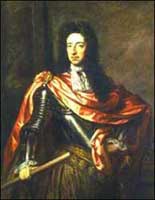
King William
III (1633 -1701).
King from 1689 to 1701).
|
King William granted
the people a Bill of Rights which eventually became the model for the
U.S. Bill of Rights. However, King William also charted the Bank of
England which made London the financial capital of the world instead
of Amsterdam.
The
Dutch also planted a colony in the New World
The
gallant Dutch nation was a leader in world exploration. They had colonies
in the Far East, Africa, and the New World.
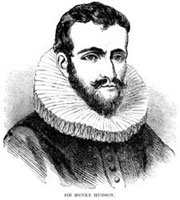
Henry Hudson
(1570-1611).
|
| |
Englishman
Henry Hudson explored the New York area for the Dutch
East India Company in 1609.
The
Dutch founded a settlement in present day New York City
called New Amsterdam. |
|
|
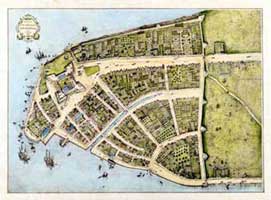
New Amsterdam
was founded by the Dutch in 1625.
|
The enterprising
Dutch even had a colony in Brazil and would eventually have replaced
the Spanish . . . and Portuguese . . . in the New World.
New
York City was formerly called New Amsterdam!!
New
York City—the greatest city in the world—was called New
Amsterdam until the city was conquered by the English in 1664, and renamed
New York, after the Duke of York—the future king James II.

King James
II (1633-1701).
King from 1685 to 1688.
|
| |
King
James II, who was overthrown in the Glorious Revolution
of 1688 by Dutch king William of Orange, was also called
the Duke of York and Albany.
New
York City was renamed after him in 1664. |
|
|

Aerial view of lower
New York City.
The city was called New Amsterdam until its conquest by the
English.
|
New York City was
named after the Duke of York in 1664.
Heroic
Holland helped establish Plymouth Plantation!!
In
1620, the first successful English colony in the New World was established
by the Pilgrim Fathers in Plymouth, Massachusetts. This colony eventually
became the nucleus for the United States, and is recognized as such
by a national Thanksgiving holiday every November.
The
Pilgrim Fathers found a refuge in Holland for 11 years prior to their
arrival in the New World. King James I—son of Mary
Queen of Scots and David Riccio, persecuted and imprisoned them.
Only by the grace of God were they able to escape from England, and
heroic Holland opened its arms of welcome to them:

City
of Leiden where the Pilgrims found a refuge.
|
| |
The
Pilgrim Fathers found a refuge in heroic Holland before
sailing to the New World. |
|
|
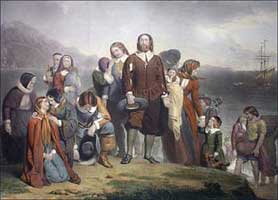
The Pilgrims
landing on Plymouth Rock.
|
Holland had a United
Provinces 200 years before the United States.....Holland was also the
first republic in the modern era that began at the Reformation, and
the U.S. Republic is modeled on that of Holland.
Vital
Links
References
Brandt,
Geeraert. History of the Reformation in the Low Countries.
T. Wood, London, 1720. Reprinted by AMS Press, New York, 1979.
Geyl,
Pieter. History of the Dutch Speaking People 1555-1648. Phoenix
Press, London, 2001.
Geyl,
Pieter. Orange and Stuart 1641-1672. Phoenix Press, London,
2001.
Grattan,
Thomas Colley, Holland. The History of the Netherlands. Peter
Fenelon Collier, New York. 1899.
Jardine,
Lisa. The Awful End of Prince William the Silent. HarperCollins,
New York, 2005.
J.W.
Schulte Nordholt & Robert P. Swierenga. A Bilateral Bicentennial.
A History of Dutch-American Relations, 1782-1982, Farrar, Straus
and Giroux, New York, 1982.
Motley,
John Lothrop. The Rise of the Dutch Republic. Harper &
Brothers, New York, 1855.
Roger
Hainsworth & Christine Churches. The Anglo-Dutch Naval Wars
1652-1674. Sutton Publishing, Gloustershire, UK, 1998.
Wylie,
J.A. History of Protestantism (in 2 volumes), Cassell Petter
& Galpin, London, 1870.
Copyright
© 2008 by Niall Kilkenny
Back to Main Menu
|





























